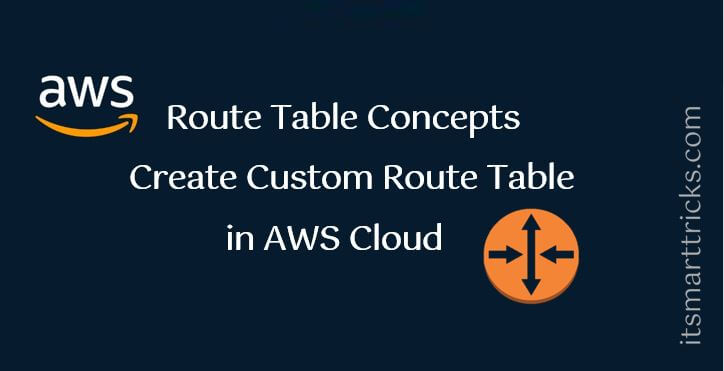A route table contains a set of rules, called routes, that are used to determine where network traffic from your subnet or gateway is directed.

Route Table Concepts:
The following are the key concepts for route tables.
Main route table — The route table that automatically comes with your VPC. It controls the routing for all subnets that are not explicitly associated with any other route table.
Custom route table — A route table that you create for your VPC.
Edge association — A route table that you use to route inbound VPC traffic to an appliance. You associate a route table with the internet gateway or virtual private gateway, and specify the network interface of your appliance as the target for VPC traffic.
Route table association — The association between a route table and a subnet, internet gateway, or virtual private gateway.
Subnet route table — A route table that’s associated with a subnet.
Gateway route table — A route table that’s associated with an internet gateway or virtual private gateway.
Local gateway route table — A route table that’s associated with an Outposts local gateway. For information about local gateways.
Destination — The range of IP addresses where you want traffic to go (destination CIDR). For example, an external corporate network with the CIDR 172.16.0.0/12.
Propagation — Route propagation allows a virtual private gateway to automatically propagate routes to the route tables. This means that you don’t need to manually enter VPN routes to your route tables. For more information about VPN routing options.
Target — The gateway, network interface, or connection through which to send the destination traffic; for example, an internet gateway.
Local route — A default route for communication within the VPC.
How route tables work?
Your VPC has an implicit router, and you use route tables to control where network traffic is directed. Each subnet in your VPC must be associated with a route table, which controls the routing for the subnet (subnet route table). You can explicitly associate a subnet with a particular route table. Otherwise, the subnet is implicitly associated with the main route table. A subnet can only be associated with one route table at a time, but you can associate multiple subnets with the same subnet route table.
You can optionally associate a route table with an internet gateway or a virtual private gateway (gateway route table). This enables you to specify routing rules for inbound traffic that enters your VPC through the gateway.
There is a quota on the number of route tables that you can create per VPC. There is also a quota on the number of routes that you can add per route table.
Create a custom route table:
Log into your AWS console, select the region in which you would like to create a route table. if you dont want default route table please delete and You can create a custom route table for your VPC using the Amazon VPC console.
Open the Amazon VPC console.
In the navigation pane, choose Route Tables.
Choose Create route table.
(Optional) For Name tag, enter a name for your route table.
For VPC, choose your VPC.

(Optional) Add or remove a tag:
[Add a tag] Choose Add tag and do the following:
- For Key, enter the key name.
- For Value, enter the key value.
[Remove a tag] Choose the Delete button (“X”) to the right of the tag’s Key and Value.
Choose Create.

Now in “Route tables” you will see the route table you created.

Route Tables Points:
- These are tables that have entries which says what is the destination and target for that packet.
- Each Subnet MUST have ONLY ONE Route Table.
- One ROUTE Table can be associated with Mutiple Subnets.
- If you don’t specify a subnet – to – route – table association, the subnet will be associated with the Main (default) VPC route table.
- Default route table that gets created automatically when you create VPC is set as Main Route Table.
- Subnet association can be changed to another Route Table (Custom).
- Custom Route Table can become Main Route Table.
- Main Route Table cannot Be deleted.
- Every Route Table has default rule for all VPC subnets to communicate (You cannot modify or delete).
That’s all, In this article, we have explained Route Table Concepts – Create Custom Route Table in AWS Cloud. If you like this article, then just share it and then do subscribe to email alerts for Linux, Windows, macOS, Android, Internet, Firewall and Security, CCTV tutorials. If you have any questions or doubts about this article, please comment.
